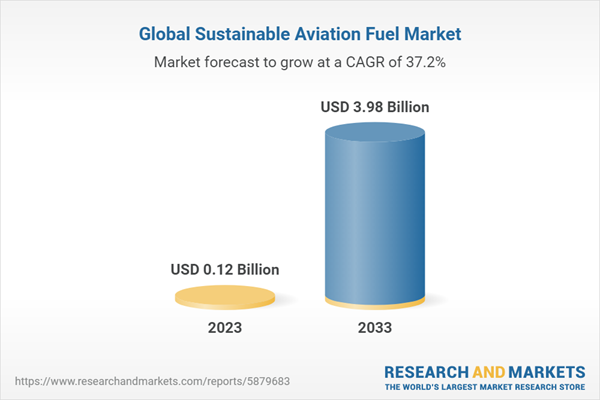The sustainable aviation market is experiencing rapid growth due to the increasing demand for eco-friendly air travel. Public awareness of the environmental impact of air travel is rising, leading to a higher demand for sustainable alternatives. Governments worldwide are implementing regulations to reduce air travel's environmental footprint, resulting in a need for new technologies and fuels to meet these requirements. Recent technological advancements are enabling the development of more sustainable aircraft and fuels.The Sustainable Aviation Fuel Market is Poised for Significant Growth as Technology Advances, Production Volumes Increase, and Economies of Scale Are Achieved
Sustainable aviation fuel (SAF) is a type of aviation fuel derived from renewable or waste feedstocks. It can be used in existing aircraft without modifications and has the potential to reduce greenhouse gas emissions by up to 80%. Various feedstocks can be used to produce SAF, including biomass from agricultural, forestry, and municipal waste, as well as waste materials like used cooking oil, animal fats, and waste plastics. Carbon dioxide can also be captured from the atmosphere or industrial processes and used to produce SAF.
The production of SAF is a complex process, but it is becoming more efficient and cost-effective. Different technologies, such as hydroprocessing, Fischer-Tropsch synthesis, and GTL, can be employed to produce SAF.
Efforts to minimize aircraft carbon emissions are focused on developing sustainable aviation fuels (SAFs), including liquid biofuels and synthetic alternatives. SAFs offer the potential to reduce emissions due to their cleaner life cycle compared to fossil fuels.
To guarantee the sustainability of SAFs, increasing production while minimizing environmental impact is crucial. Despite advancements, some biofuels may not significantly mitigate aviation's climate impact in current scenarios.
SAF is a biofuel used in airplanes with similar properties to regular jet fuel but with a lower carbon footprint. Depending on the feedstock and production methods, SAF can significantly reduce life cycle greenhouse gas emissions compared to traditional jet fuel. Some new SAF approaches even exhibit negative greenhouse gas footprints. The growth, sourcing, and production of SAF from renewable and waste sources can create economic opportunities in rural areas, improve the environment, and enhance aircraft performance. SAFs often have fewer aromatic components, leading to cleaner combustion in airplane engines, resulting in fewer harmful emissions around airports during takeoff and landing. Additionally, these aromatic components can contribute to the formation of contrails, which exacerbate climate change effects.
The sustainable aviation fuel market's growth is driven by governments implementing regulations to reduce air travel's environmental impact and the advancements in technology enabling the development of more sustainable aircraft and fuels.
In terms of market dynamics, the biofuel technology segment is the most popular, accounting for the majority of the market share. Additionally, commercial aviation is the largest application segment, contributing the most to the market share.
Recent developments include IAG Cargo collaborating with Kuehne+Nagel to reduce cargo customers' supply chain emissions by purchasing six million liters of SAF in 2023. The SAF, made from used cooking oil and food waste, is certified by the International Sustainability & Carbon Certification (ISCC) and has at least 80% lower lifecycle emissions than conventional jet fuel, saving over 15,000 tonnes of CO2.
Table of Contents
Sustainable Aviation Fuel Market Report DefinitionExpert Opinions on Sustainable Aviation Fuel Market ReportConclusions
Sustainable Aviation Fuel Market Segmentation
Sustainable Aviation Fuel Market Analysis for next 10 Years
Market Technologies of Sustainable Aviation Fuel Market
Global Sustainable Aviation Fuel Market Forecast
Regional Sustainable Aviation Fuel Market Trends & Forecast
Country Analysis of Sustainable Aviation Fuel Market
Opportunity Matrix for Sustainable Aviation Fuel Market
Table Information
| Report Attribute | Details |
|---|---|
| No. of Pages | 150 |
| Published | September 2023 |
| Forecast Period | 2023 - 2033 |
| Estimated Market Value ( USD | $ 0.12 Billion |
| Forecasted Market Value ( USD | $ 3.98 Billion |
| Compound Annual Growth Rate | 37.1% |
| Regions Covered | Global |









